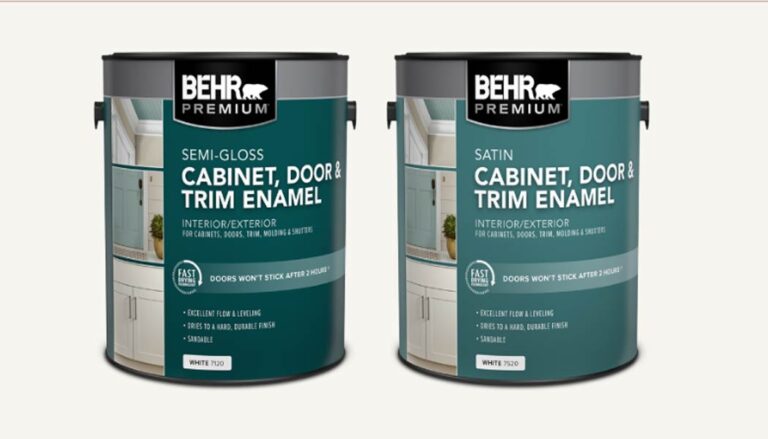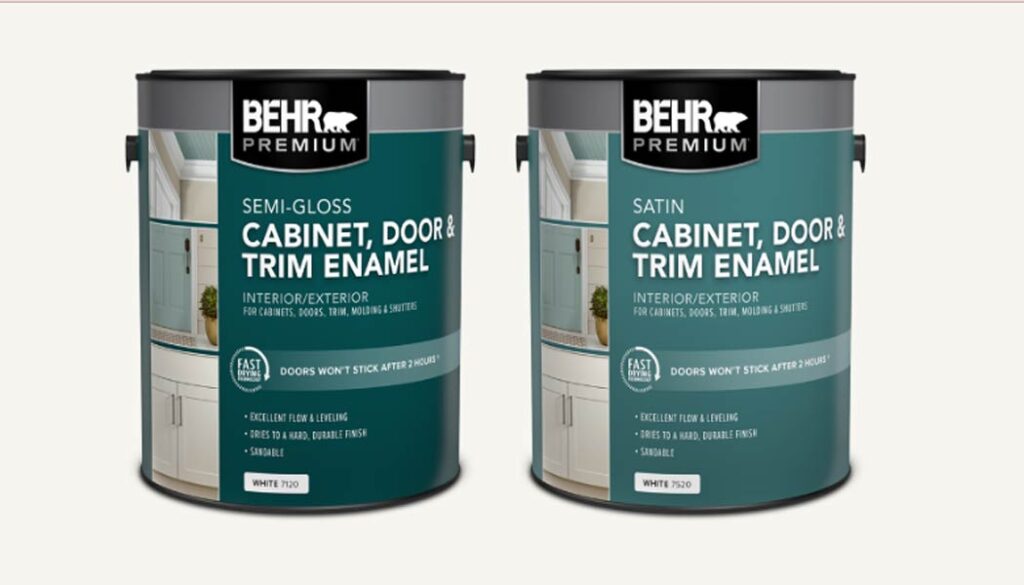
Is Behr Enamel Paint Latex?
Behr Enamel Paint is not latex-based. It is an oil-based paint, which differentiates it from latex paint, which is water-based.
Selecting the right paint is pivotal for any painting project’s success. Among the diverse options available, Behr Enamel Paint is celebrated for its resilience and adaptability. Yet, as we stand before the colorful array of paint cans, one question often lingers: Is Behr Enamel Paint latex-based?

To embark on a painting project with confidence, it’s imperative to grasp the essence of the paint at hand. In this article, we’ll discuss the true nature of Behr Enamel Paint, whether it aligns with latex-based paints or stands independently as an oil-based masterpiece.
By the end of this exploration, you’ll have a crystal-clear understanding of Behr Enamel Paint’s composition. It’ll pave the way for well-informed decisions in your painting endeavors.
What Kind of Paint Is Behr Enamel?
When it comes to giving life to our creative visions, paint becomes an indispensable tool. In this context, Behr Enamel Paint emerges as a prominent choice. It’s like a trusted companion on an artistic journey, but before we embark on that path, let’s understand its essence.
Behr Enamel Paint, renowned for its resilience and adaptability, falls under the category of oil-based paint. These oils bestow a distinct character to Behr Enamel Paint, manifesting in its glossy finish and robust nature. This remarkable glossiness makes it an ideal candidate for projects demanding enduring and visually appealing outcomes.
This distinction is vital in understanding its unique properties and applications. Oil-based paints, including Behr Enamel Paint, differ from their water-based counterparts, commonly known as latex paints, in several key aspects.
The defining characteristic of Behr Enamel Paint is its use of oils as solvents to carry the paint’s pigments. These oils, which can include linseed oil or mineral spirits, endow the paint with distinct features that set it apart. One prominent attribute is its glossy finish, which adds a luxurious sheen to surfaces. This high gloss is prized for its ability to create a durable, polished appearance.
Furthermore, the oil-based nature of Behr Enamel Paint contributes to its exceptional durability and resilience. This type of paint is well-suited for projects where longevity is paramount, such as painting trim, doors, or furniture. Its ability to withstand wear and tear makes it an excellent choice for surfaces that will see frequent use or exposure to the elements.
Shortly, it is an oil-based paint renowned for its glossy finish, durability, and versatility. Its distinctive properties make it a preferred choice for various projects, providing a lasting and visually appealing finish. Understanding its oil-based composition is essential for using it effectively in different applications.
Is Behr Enamel Paint Latex?
Among a vast number of kinds of paint, latex and enamel represent two distinct realms. Each comes with its own characteristics and applications. To clarify any misconceptions, let’s be unequivocal: Behr Enamel Paint is not latex-based. It stands apart from the latex paint family by virtue of its composition.
To appreciate this distinction, we must grasp the fundamental divergence between latex and enamel paints. Latex paint, also referred to as water-based paint, employs water as its solvent to carry the pigment.
Conversely, enamel paint employs oil or solvent-based carriers. Behr Enamel Paint aligns with the latter category, utilizing oil as its base, thus clearly differentiating it from latex paint.
Behr Enamel Paint employs oils, typically linseed oil or mineral spirits, as the solvent, imparting a glossy finish and remarkable durability to the paint. The use of oil-based solvents sets it apart from latex paint, which relies on water as its primary solvent.
This differentiation is crucial to understand because it impacts how the paint behaves. So, if you’re working with Behr Enamel Paint, rest assured that it is not latex-based, and you should follow the appropriate techniques for oil-based paints in your projects.
How to Determine If Behr Enamel Paint is Latex?
The essence of DIY projects often hinges on understanding the materials we employ. So, what if you find yourself in a situation where the paint type isn’t explicitly labeled? How can you discern whether the Behr Enamel Paint you possess is, indeed, not latex-based?
A. Check the Label: Commence your investigation by scrutinizing the label adorning the paint can or container. Behr is renowned for its transparent labeling practices. Inspect for any mentions specifying the paint type. If it’s enamel, it will be clearly stated, eliminating any ambiguity regarding its latex composition.
B. Smell Test: Oftentimes, the sensory approach can offer valuable insights. Enamel paints tend to emanate a stronger, more pungent odor in comparison to latex paints. This happens due to their oil-based nature. Give the can a brief sniff test. If the odor strikes you as robust and chemical-like, it’s a telltale sign of enamel paint.
C. Consistency Assessment: Another avenue to explore involves assessing the paint’s consistency. Generally, latex paints exhibit a thinner, more liquid nature, while enamel paints, including Behr Enamel Paint, possess a denser, more viscous texture.
D. Cleanup Protocol: Cleaning brushes or tools post-painting often reveals the paint’s true identity. Enamel paints necessitate the use of a solvent such as paint thinner or mineral spirits for effective cleanup. In contrast, latex paints can be easily cleansed with water.
One can easily determine if a Behr Enamel Paint is latex or not.
How to Use Behr Enamel Paint If It Is Latex?
Now that we’ve established the oil-based nature of Behr Enamel Paint let’s delve into the practical aspect of its utilization, especially when one initially intended to work with latex paint. Fear not, for adaptation is the key to creative triumph.
A. Surface Preparation: Regardless of the paint type, the initial step remains consistent: prepare the canvas. Ensure the surface is devoid of any debris, dirt, or loose particles. If necessary, employ light sanding to attain a smooth and uniform foundation for the paint.
B. Adequate Ventilation: Whether you’re engaging with latex or enamel paint, one aspect should never be compromised – ventilation. Enamel paints, in particular, have a propensity for emitting potent fumes. Thus, it’s imperative to work in a well-ventilated environment, safeguarding your health.
C. Application Technique: The application process remains a pivotal aspect of achieving the desired results. Apply Behr Enamel Paint evenly using a top-tier brush or roller. Adhere to the manufacturer’s recommendations concerning drying intervals between successive coats.
D. Cleanup Routine: As emphasized earlier, Behr Enamel Paint necessitates the use of a solvent, such as paint thinner, for effective cleanup. Promptly clean your brushes and tools post-application to maintain their longevity and performance.
E. Drying Time Patience: One significant deviation between latex and enamel paints lies in their drying duration. Enamel paints typically mandate a lengthier drying period. Exercise patience and allocate ample time for each coat to fully dry before considering additional layers.
Final Words
Behr Enamel Paint stands as a testament to versatility and durability, emerging as an indispensable ally in the realm of creative projects. Clearing the confusion, we reiterate that Behr Enamel Paint is unequivocally not latex-based; rather, it thrives on an oil-based foundation, fostering its unique properties.
In our artistic endeavors, should we find ourselves with Behr Enamel Paint when the intention was latex, adaptability becomes our greatest asset. Although we can check if Behr Enamel Paint and if it is latex, we can still make use of it spontaneously.
